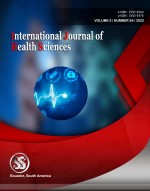Midline stoma via the umbilicus versus traditional diverting loop ileostomy
A retrospective comparative study
Keywords:
Umbilical stoma, Ileostomy, Laparoscopic colorectal surgery, Diverting stoma, Faecal diversionAbstract
Diverting loop ileostomies have traditionally been fashioned in the right iliac fossa, but a novel technique of midline loop ileostomy at the umbilical port site during colorectal surgeries have been described. We aim to compare outcomes after creation and reversal of these two types of ileostomy. Using a retrospective study design, 10 consecutive patients who underwent a midline loop ileostomy were compared with 10 consecutive patients who underwent a traditional right iliac fossa stoma. Baseline characteristics, operating time, length of stay and complications for the initial operation as well as reversal of stoma operation were compared between the two groups. There was no significant difference in duration of operation or complication rate after the initial stoma formation, but length of hospital stay was longer in the traditional stoma group (10 vs 4.5 days, p = 0.04). After reversal of ileostomy, the traditional stoma group had a significantly higher perioperative complication rate compared to the midline stoma group (50 vs 0%, p = 0.03), but there was no difference in operation time or length of hospital stay.
Downloads
References
Beitz J et al (2010) Content validation of a standardized algorithm for ostomy care. Ostomy Wound Manage 56(10):22–38
Chow A, Tilney HS, Paraskeva P, Jeyarajah S, Zacharakis E, Purkayastha S (2009 Jun 1) The morbidity surrounding reversal of defunctioning ileostomies: a systematic review of 48 studies including 6,107 cases. Int J Color Dis 24(6):711
Eto K et al (2013) Transumbilical defunctioning ileostomy: a new approach for patients at risks of anastomotic leakage after laparoscopic low anterior resection. Anticancer Res 33(11):5011–5015
Fitzgerald PG, Lau GY, Cameron GS (1989) Use of the umbilical site for temporary ostomy: review of 47 cases. J Pediatr Surg 24(10):973
Gessler B, Haglind E, Angenete E (2012) Loop ileostomies in colorectal cancer patients–morbidity and risk factors for nonreversal. J Surg Res 178(2):708–714
Hiranyakas A et al (2013) Loop ileostomy closure after laparoscopic versus open surgery: is there a difference? Surg Endosc 27(1):90– 94
Kaidar-Person O, Person B, Wexner SD (2005) Complications of construction and closure of temporary loop ileostomy. J Am Coll Surg 201(5):759–773
Karanjia ND et al (1994) Leakage from stapled low anastomosis after total mesorectal excision for carcinoma of the rectum. Br J Surg 81(8):1224–1226
Matthiessen P et al (2007) Defunctioning stoma reduces symptomatic anastomotic leakage after low anterior resection of the rectum for cancer: a randomized multicenter trial. Ann Surg 246(2):207– 214
Mushaya CD et al (2015) Temporary diverting ileostomy via the umbilicus: a small case series. Int Surg 100:436–443
Redmond C, Cowin C, Parker T (2009) The experience of faecal leakage among ileostomists. Br J Nurs 18(17):S12–S17
Seow-En I, Daud MA, Seow-Choen F (2011) The umbilicus as a site for defunctioning ileostomies. Tech Coloproctol 15(2):213–214
Silva MA, Ratnayake G, Deen KI (2003) Quality of life of stoma patients: temporary ileostomy versus colostomy. World J Surg 27(4):421–424
Suryasa, I. W., Rodríguez-Gámez, M., & Koldoris, T. (2021). The COVID-19 pandemic. International Journal of Health Sciences, 5(2), vi-ix. https://doi.org/10.53730/ijhs.v5n2.2937
Tilyakov, H. A., Valiyev, E. Y., Tilyakov, A. B., & Tilyakov, A. B. (2021). A new approach to surgical treatment of victims with pelvic and femoral fracture injuries, taking into account the severity of the condition and the severity of the injury. International Journal of Health & Medical Sciences, 4(3), 338-346. https://doi.org/10.31295/ijhms.v4n3.1763
Williams J et al (2010) Evaluating skin care problems in people with stomas. Br J Nurs 19(17):S6–S15
Published
How to Cite
Issue
Section
Copyright (c) 2022 International journal of health sciences

This work is licensed under a Creative Commons Attribution-NonCommercial-NoDerivatives 4.0 International License.
Articles published in the International Journal of Health Sciences (IJHS) are available under Creative Commons Attribution Non-Commercial No Derivatives Licence (CC BY-NC-ND 4.0). Authors retain copyright in their work and grant IJHS right of first publication under CC BY-NC-ND 4.0. Users have the right to read, download, copy, distribute, print, search, or link to the full texts of articles in this journal, and to use them for any other lawful purpose.
Articles published in IJHS can be copied, communicated and shared in their published form for non-commercial purposes provided full attribution is given to the author and the journal. Authors are able to enter into separate, additional contractual arrangements for the non-exclusive distribution of the journal's published version of the work (e.g., post it to an institutional repository or publish it in a book), with an acknowledgment of its initial publication in this journal.
This copyright notice applies to articles published in IJHS volumes 4 onwards. Please read about the copyright notices for previous volumes under Journal History.
















